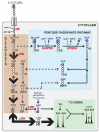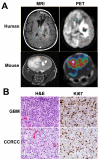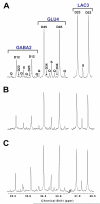Glucose metabolism via the pentose phosphate pathway, glycolysis and Krebs cycle in an orthotopic mouse model of human brain tumors
- PMID: 22383401
- PMCID: PMC3670098
- DOI: 10.1002/nbm.2787
Glucose metabolism via the pentose phosphate pathway, glycolysis and Krebs cycle in an orthotopic mouse model of human brain tumors
Abstract
It has been hypothesized that increased flux through the pentose phosphate pathway (PPP) is required to support the metabolic demands of rapid malignant cell growth. Using orthotopic mouse models of human glioblastoma (GBM) and renal cell carcinoma metastatic to brain, we estimated the activity of the PPP relative to glycolysis by infusing [1,2-(13) C(2) ]glucose. The [3-(13) C]lactate/[2,3-(13) C(2) ]lactate ratio was similar for both the GBM and brain metastasis and their respective surrounding brains (GBM, 0.197 ± 0.011 and 0.195 ± 0.033, respectively (p = 1); metastasis: 0.126 and 0.119 ± 0.033, respectively). This suggests that the rate of glycolysis is significantly greater than the PPP flux in these tumors, and that the PPP flux into the lactate pool is similar in both tumors. Remarkably, (13) C-(13) C coupling was observed in molecules derived from Krebs cycle intermediates in both tumor types, denoting glucose oxidation. In the renal cell carcinoma, in contrast with GBM, (13) C multiplets of γ-aminobutyric acid (GABA) differed from its precursor glutamate, suggesting that GABA did not derive from a common glutamate precursor pool. In addition, the orthotopic renal tumor, the patient's primary renal mass and brain metastasis were all strongly immunopositive for the 67-kDa isoform of glutamate decarboxylase, as were 84% of tumors on a renal cell carcinoma tissue microarray of the same histology, suggesting that GABA synthesis is cell autonomous in at least a subset of renal cell carcinomas. Taken together, these data demonstrate that (13) C-labeled glucose can be used in orthotopic mouse models to study tumor metabolism in vivo and to ascertain new metabolic targets for cancer diagnosis and therapy.
Copyright © 2012 John Wiley & Sons, Ltd.
Figures






References
-
- Gogvadze V, Zhivotovsky B, Orrenius S. The Warburg effect and mitochondrial stability in cancer cells. Mol Aspects Med. 2010;31(1):60–74. - PubMed
-
- Scofield RF, Kosugi K, Chandramouli V, Kumaran K, Schumann WC, Landau BR. The nature of the pentose pathway in liver. J Biol Chem. 1985;260(29):15439–44. - PubMed
-
- Magnusson I, Wennlund A, Chandramouli V, Schumann WC, Kumaran K, Wahren J, Landau BR. Fructose-6-phosphate cycling and the pentose cycle in hyperthyroidism. J Clin Endocrinol Metab. 1990;70(2):461–6. - PubMed
Publication types
MeSH terms
Substances
Grants and funding
LinkOut - more resources
Full Text Sources
Medical
Miscellaneous

